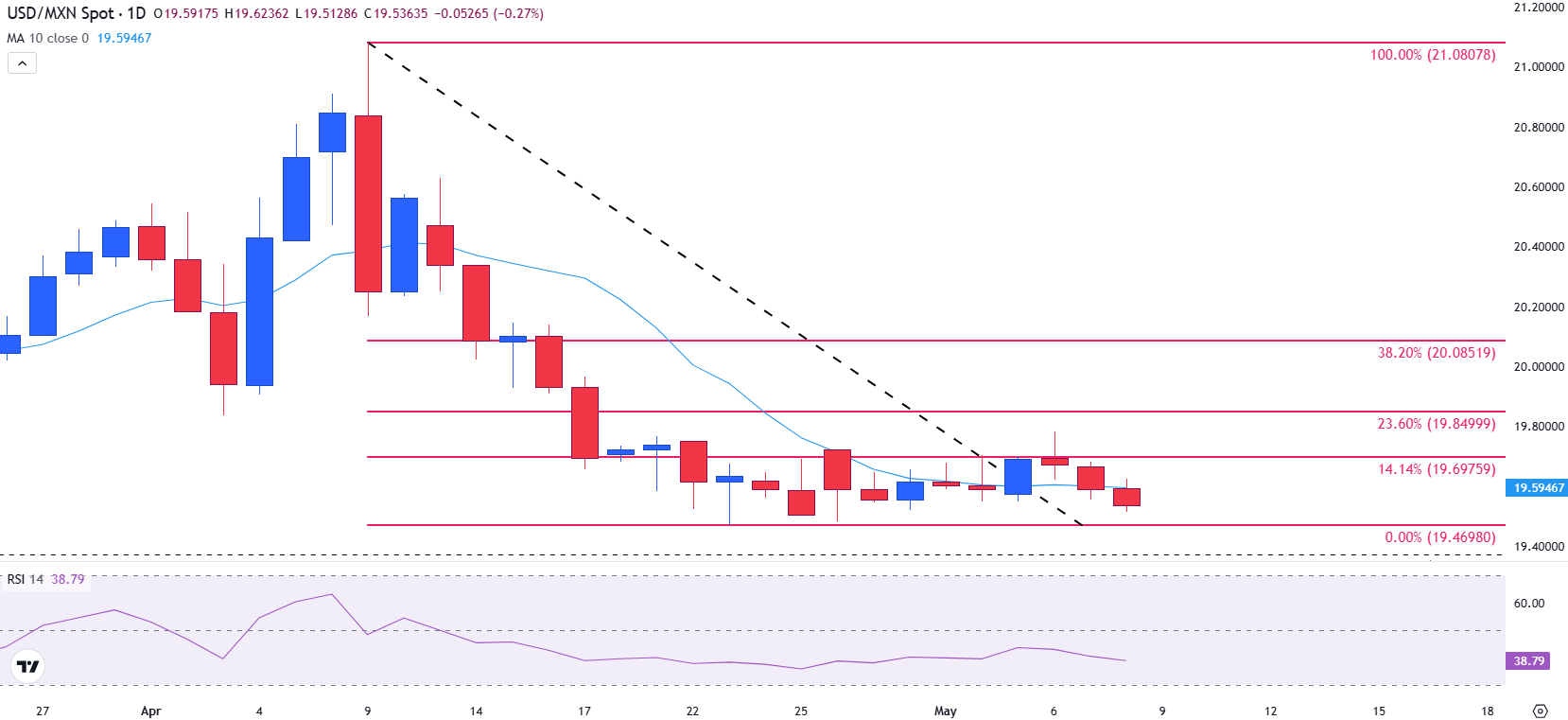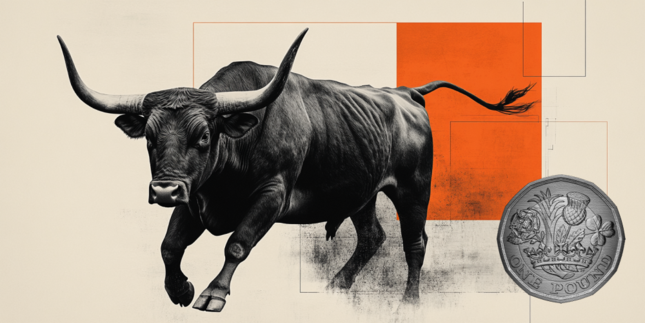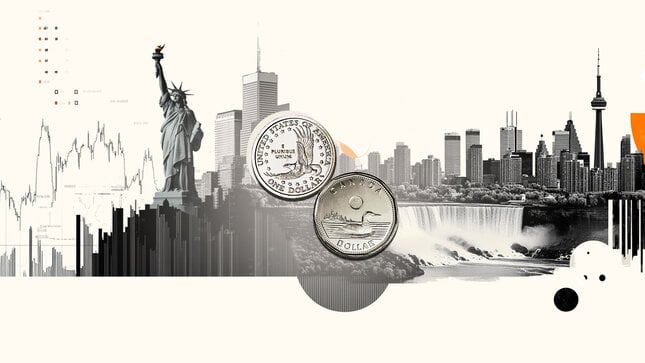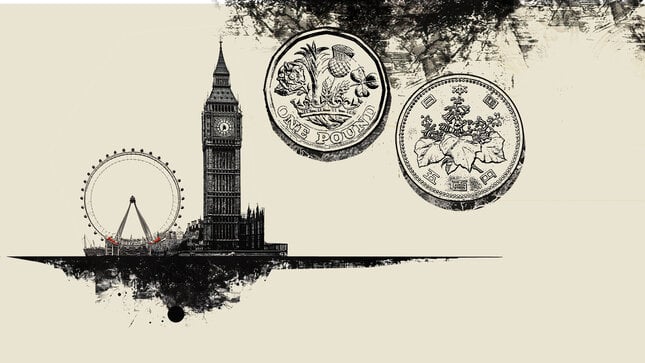Mexican Peso firms as inflation accelerates more than expected
- The Mexican Peso remains supported by improved risk sentiment ahead of US-China trade talks
- Mexico's inflation report highlights elevated price pressures, shifting focus to the Banxico May 15 meeting
- USD/MXN continues to trade in a tight range, with imminent resistance at 19.60
The Mexican Peso (MXN) swings between mild gains and losses against the US Dollar (USD) on Thursday, as markets digest stronger-than-expected Mexican inflation data alongside a cautious Federal Reserve and the upcoming US-China trade talks.
At the time of writing, USD/MXN is down 0.26%, trading near 19.53 holding steady within a narrow range after failing to break below key support earlier this week.
Mexico's inflation data ticks higher a week before the Banxico rate decision
On Thursday, Mexico’s April inflation report showed price growth accelerating to 3.93% year-on-year, above the 3.90% forecast and 0.10 percentage points higher than the same month last year. Core inflation rose 0.49% month-on-month, up from 0.43% in March and exceeding expectations of 0.47%, while headline inflation climbed 0.33%, also above the prior reading of 0.31%.
The upside surprise in both headline and core figures signals persistent underlying pressures and adds complexity for Banxico, which is scheduled to meet next week.
While a 25–50 bps rate cut is still widely expected on May 15, today’s data may prompt policymakers to adopt a more cautious tone or slow the pace of easing thereafter.
Meanwhile, the Federal Reserve (Fed) left its benchmark interest rate unchanged at 4.25% - 4.50% on Wednesday, with Fed Chair Jerome Powell emphasizing a “wait-and-see” approach in the face of persistent inflation uncertainty and uneven growth.
Traders are now weighing the implications of the Fed’s "wait-and-see" approach, a mild inflation overshoot in Mexico, and broader geopolitical risks. Market attention is shifting toward next week’s Banxico meeting, with interest rate differentials, trade policies, and political positioning continuing to shape expectations.
Mexican Peso daily digest - USD/MXN latest developments
- Sentiment in markets turned risk-on after news that US President Donald Trump is expected to provide details about a trade deal between the US and the UK on Thursday.
- The Banxico is expected to cut rates by between 25 and 50 basis points (bps) on May 15.
- However, an increase in the Core inflation may limit additional rate cuts in the second half of the year
- Fiscal support measures announced for low-income groups on Monday may add stimulus pressure, potentially weighing on the Peso as rate differentials with the US narrow.
- Mexican President Claudia Sheinbaum reaffirmed support for the USMCA (T-MEC) on Wednesday, amid concerns the Trump administration could push for revisions. The agreement provides duty-free access to the US and Canadian markets, which is key for Mexican exports. Any disruption could undermine trade and Peso sentiment.
- Global sentiment has improved since Tuesday, following reports of US-China trade talks scheduled this weekend in Switzerland, where Treasury Secretary Scott Bessent and Jamieson Greer will meet Chinese officials. A constructive outcome could support emerging market assets.
- Mexico remains exposed to targeted US tariffs on steel and auto exports, with broader measures threatened under Trump’s trade agenda. Further escalation could dampen investor confidence and pressure the Peso.
- Mexico’s Q1 Gross Domestic Product (GDP) rose 0.2%, narrowly avoiding recession, while the US economy contracted by 0.3%, missing estimates. Slower US growth raises pressure on the Fed, but policymakers remain cautious on cuts.
- Fed Chair Powell reiterated on Wednesday a data-driven approach, saying, “The right thing to do is await further clarity,” and warned that tariff-driven inflation could delay policy easing.
- Recent US tariffs on key Mexican exports – including metals and autos – have added pressure to the external sector, weighing on trade and investment outlooks.
USD/MXN falls below critical support as bearish momentum gains
USD/MXN is trading below the technically significant psychological level of 19.60 at the time of writing on Thursday, which aligns with the 10-day Simple Moving Average (SMA) and the mid-level of the tight range between 19.46 and 19.76 seen since April 18, suggesting fading bullish momentum and indecision among traders.
Support remains anchored at the April low and the bottom of the range at 19.46, with the Relative Strength Index (RSI) falling below 40, reflecting an increase in bearish momentum without entering oversold territory.
A break below Wednesday’s low of 19.56 would re-expose the April low and deepen downside risk.
To regain upward traction, the pair would need a clean daily close above 19.60 and the next psychological resistance level of 19.76, which could open the door toward the 23.60% Fibonacci retracement level of the April move at 19.85, though buyers remain hesitant ahead of next week’s Banxico decision.
USD/MXN daily chart

Inflation FAQs
Inflation measures the rise in the price of a representative basket of goods and services. Headline inflation is usually expressed as a percentage change on a month-on-month (MoM) and year-on-year (YoY) basis. Core inflation excludes more volatile elements such as food and fuel which can fluctuate because of geopolitical and seasonal factors. Core inflation is the figure economists focus on and is the level targeted by central banks, which are mandated to keep inflation at a manageable level, usually around 2%.
The Consumer Price Index (CPI) measures the change in prices of a basket of goods and services over a period of time. It is usually expressed as a percentage change on a month-on-month (MoM) and year-on-year (YoY) basis. Core CPI is the figure targeted by central banks as it excludes volatile food and fuel inputs. When Core CPI rises above 2% it usually results in higher interest rates and vice versa when it falls below 2%. Since higher interest rates are positive for a currency, higher inflation usually results in a stronger currency. The opposite is true when inflation falls.
Although it may seem counter-intuitive, high inflation in a country pushes up the value of its currency and vice versa for lower inflation. This is because the central bank will normally raise interest rates to combat the higher inflation, which attract more global capital inflows from investors looking for a lucrative place to park their money.
Formerly, Gold was the asset investors turned to in times of high inflation because it preserved its value, and whilst investors will often still buy Gold for its safe-haven properties in times of extreme market turmoil, this is not the case most of the time. This is because when inflation is high, central banks will put up interest rates to combat it. Higher interest rates are negative for Gold because they increase the opportunity-cost of holding Gold vis-a-vis an interest-bearing asset or placing the money in a cash deposit account. On the flipside, lower inflation tends to be positive for Gold as it brings interest rates down, making the bright metal a more viable investment alternative.
Forex News
Keep up with the financial markets, know what's happening and what is affecting the markets with our latest market updates. Analyze market movers, trends and build your trading strategies accordingly.
















